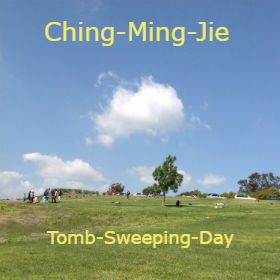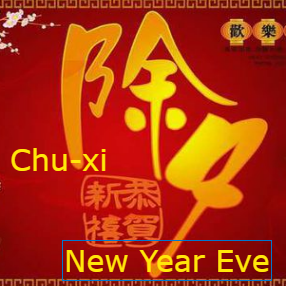
Ching-Ming (清明) – Tomb Sweeping Day and the Fifth Solar Term
Ching-Ming (noun): A traditional Chinese festival and solar term.
In Chinese:
-
“清” (qing) = pure
-
“明” (ming) = bright
🌸 What Is Ching-Ming?
Ching-Ming, also known as Tomb Sweeping Day, is a traditional Chinese festival that falls on the first day of the fifth solar term in the lunisolar calendar. It usually occurs around April 4th or 5th in the Gregorian calendar, 15 days after the Spring Equinox.
As one of the 24 solar terms (节气 Jieqi), Ching-Ming reflects both seasonal change and cultural tradition. Originally rooted in farming life, it is still widely observed across Chinese communities today.
🧹 Ching-Ming Festival Traditions
The most well-known tradition is tomb sweeping (扫墓 Sǎomù). Families visit ancestral graves to clean the tombs, offer food, and honor their ancestors. It’s a day of remembrance, respect, and spiritual connection.
Ching-Ming is also a joyful time to enjoy the spring. Families take part in spring outings, known as:
-
春游 (chūn yóu) – “spring tour”
-
踏青 (tà qīng) – “stepping on the green”
These traditions allow people to appreciate nature and the rebirth of life in spring.
The Three Periods of Ching-Ming
Each solar term in the traditional calendar is divided into three climate periods (候 hòu). These poetic observations mark changes in nature:
-
桐始华 (Tóng shǐ huá) – Tung tree blossoms begin to bloom
-
田鼠化为鹌 (Tiánshǔ huà wéi ān) – “Voles turn into quails,” symbolizing their retreat underground
-
虹始见 (Hóng shǐ jiàn) – Rainbows appear with increasing spring sunshine and rain
🌬️ Flower Letter Breeze (花信风) of Ching-Ming
Each jieqi period is linked to a “flower letter breeze”—a poetic term for seasonal winds that bring blooming flowers.
During Ching-Ming:
-
First Period: Vernicia flowers (桐花)
-
Second Period: Wheat blossoms (麦花)
-
Third Period: Willow blossoms (柳花)
Other flowers like begonias, magnolias, and peach blossoms also bloom during this time, making spring outings extra beautiful.
🕯️ Tomb Sweeping Rituals (扫墓 Sǎomù)
Ching-Ming is known for its deep ancestor-honoring rituals, many of which are still practiced today:
-
Cleaning the Tomb: Families sweep leaves, remove weeds, and wash tombstones.
-
Food and Tea Offerings: Meals, tea, wine, and even cigarettes are offered to ancestors.
-
Burning Joss Paper (纸钱 Zhǐqián): Also called “spirit money,” it’s burned to support the ancestors in the afterlife.
-
Lighting Incense and Firecrackers: These help communicate with the spirit world and drive away evil.
-
Bowing or Kowtowing (磕头 Kētóu): Deep bows or kneeling rituals are performed as acts of filial piety.
-
Wearing Willow Branches (插柳 Chāliǔ): Willow is used for protection and symbolizes renewal.
Regional Differences in Ching-Ming
While the core meaning remains the same, Ching-Ming traditions vary by region:
-
In Taiwan: People often make offerings of spring rolls and herbal rice. Festivals may include parades and folk performances.
-
In Hong Kong: It’s a public holiday. Many use the day for picnics at cemeteries, blending remembrance with leisure.
-
Among Overseas Chinese in Southeast Asia: People in Malaysia, Singapore, and Indonesia observe Ching-Ming by gathering extended families to visit cemeteries, often combining it with feasts and storytelling.
🆚 Ching-Ming vs. Hungry Ghost Festival
These two holidays are often confused but serve different purposes:
-
Ching-Ming (清明): Held in spring; focused on honoring ancestors with care and reflection.
-
Hungry Ghost Festival (中元节 Zhōngyuánjié): Held in summer; focused on appeasing wandering spirits to avoid misfortune.
Ching-Ming is about remembrance. Hungry Ghost is about protection.
Modern-Day Changes
As lifestyles shift, some modern adaptations of Ching-Ming include:
-
Digital Tomb Sweeping: Families can now light virtual candles and burn “e-offerings” via apps.
-
Eco-Friendly Offerings: Some are switching to flowers and biodegradable incense to reduce pollution.
-
Flexible Observance: People now visit tombs days before or after the official date, especially if they live far away.
Despite these changes, the spirit of filial piety and remembrance remains strong.
Ching-Ming in Poetry and Art
Ching-Ming has inspired countless poets and painters. One famous poem by Du Mu (杜牧) expresses the festival’s bittersweet feeling:
清明时节雨纷纷,路上行人欲断魂。
(During Ching-Ming, drizzling rain falls like tears; travelers on the road feel brokenhearted.)
This shows how Ching-Ming is not only about rituals but also deep emotional reflection.
✅ Conclusion
Ching-Ming is more than just a holiday—it’s a powerful blend of nature, memory, and tradition. From sweeping tombs to walking in spring meadows, people honor their ancestors while celebrating the cycle of life.
Whether you’re burning incense in a quiet cemetery or enjoying blossoms on a family hike, Ching-Ming connects generations and reminds us of life’s natural flow. It remains one of the most meaningful and poetic traditions in Chinese culture.
-
Definition of Ching-Ming (清明) — with the breakdown of 清 = pure and 明 = bright
-
Mention of it being the 5th solar term, 15 days after the Spring Equinox
-
Date range (April 4–5), and its place in the Chinese lunisolar calendar
-
24 solar terms (节气) context
-
Tomb sweeping tradition
-
Three climate periods (候 hòu):
-
桐始华 – tung blossoms
-
田鼠化为鹌 – voles “turn into” quails
-
虹始见 – rainbow appears
-
-
Connection to flowers and the poetic term flower letter breeze (花信风)
-
Spring tour (春游) and 踏青 (taqing) as part of Ching-Ming
-
reminder that it’s both a solar term and traditional festival
#ChingMing #QingMingFestival #TombSweepingDay #ChineseTraditions #LunarCalendar #SpringOuting #FlowerLetterBreeze #AncestorWorship #扫墓 #清明节 #CulturalFestivals #ModernTraditions #ChinesePoetry #SolarTerms

